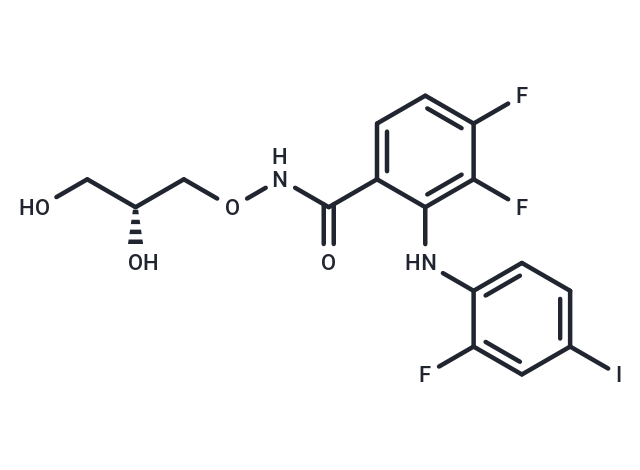购物车
- 全部删除
 您的购物车当前为空
您的购物车当前为空

Mirdametinib (PD325901) 是一种 MEK 抑制剂 (IC50=0.33 nM),具有选择性、非 ATP 竞争性和口服活性。Mirdametinib 具有抗肿瘤活性,可以抑制 p-ERK1/2 的表达并诱导细胞凋亡。


为众多的药物研发团队赋能,
让新药发现更简单!
Mirdametinib (PD325901) 是一种 MEK 抑制剂 (IC50=0.33 nM),具有选择性、非 ATP 竞争性和口服活性。Mirdametinib 具有抗肿瘤活性,可以抑制 p-ERK1/2 的表达并诱导细胞凋亡。
| 规格 | 价格 | 库存 | 数量 |
|---|---|---|---|
| 1 mg | ¥ 189 | 现货 | |
| 5 mg | ¥ 428 | 现货 | |
| 10 mg | ¥ 738 | 现货 | |
| 25 mg | ¥ 1,420 | 现货 | |
| 50 mg | ¥ 2,190 | 现货 | |
| 100 mg | ¥ 3,590 | 现货 | |
| 200 mg | ¥ 4,880 | 现货 | |
| 1 g | ¥ 6,590 | 5日内发货 | |
| 1 mL x 10 mM (in DMSO) | ¥ 461 | 现货 |
| 产品描述 | Mirdametinib (PD325901) is an MEK inhibitor (IC50=0.33 nM) with selective, non-ATP-competitive, and oral activity. Mirdametinib exhibits antitumor activity by inhibiting p-ERK1/2 expression and inducing apoptosis. |
| 靶点活性 | MEK:0.33 nM (cell free) |
| 体外活性 | 方法:11 种人黑色素瘤细胞系上用 Mirdametinib (0.1-1000 nM) 处理 72 h,使用 trypan blue exclusion test 检测细胞数。 结果:Mirdametinib (IC50=20-50 nM) 有效抑制具有 BRAF 突变 (M14/A375P/A375M/A375SM/ME10538/ME4686/JR8) 或不具有 BRAF 突变 (ME4405/ME13923) 的人黑色素瘤细胞系的生长。ME1007 和 ME8959均具有野生型 BRAF,对 Mirdametinib介导的生长抑制的抗性略高 (IC50≥100 nM)。[1] 方法:乳头状甲状腺癌 (PTC) 细胞系 K2 和 TPC-1 用 Mirdametinib (0.1-1000 nmol/L) 处理 1-96 h,使用 Western Blot 检测靶点蛋白表达水平。 结果:Mirdametinib 可以有效抑制多种 PTC 细胞系中 ERK1/2 的磷酸化。[2] |
| 体内活性 | 方法:为检测体内抗肿瘤活性,将 Mirdametinib (20-25 mg/kg,80 mmol/L citric buffer (pH 7)) 灌胃给药给携带 PTC 肿瘤 K2 或 TPC-1 的 Athymic Ncr-nu/nu 小鼠,每周五次,持续三周。 结果:Mirdametinib 在接种携带 BRAF 突变的 PTC 细胞 K2 的小鼠中完全抑制肿瘤生长,并且在接种携带 RET/PTC1 重排的 PTC 细胞 TPC-1 的小鼠中显着降低肿瘤生长。[2] 方法:为检测体内抗肿瘤活性,将 Mirdametinib (1.6-25 mg/kg,0.5% hydroxypropylmethylcellulose+0.2% Tween 80 in water) 口服给药给携带小鼠结直肠癌肿瘤 CT26 的小鼠,每天一次,持续十四天。 结果:Mirdametinib 显著抑制肿瘤中的 pERK 水平。[3] |
| 激酶实验 | Incorporation of 32P into myelin basic protein (MBP) is assayed in the presence of a glutathione S-transferase fusion protein containing p44MAP kinase (GST-MAPK) and a glutathione S-transferase protein containing p45MEK (GST-MEK). The assay solution contained 20 mM HEPES, pH 7.4, 10 mM MgCl2, 1 mM MnCl2, 1 mM EGTA, 50 mM [γ-32P]ATP, 10 mg GST-MEK, 0.5 mg GST-MAPK and 40 mg MBP in a final volume of 100 mL. Reactions are stopped after 20 minutes by addition of trichloroacetic acid and filtered through a GF/C filter mat. 32P retained on the filter mat is determined using a 1205 Betaplate [1]. |
| 细胞实验 | A cell death detection enzyme-linked immunosorbent assay was used per the manufacturer's instructions. Briefly, 4 × 10^4 cells were plated in 24-well plates in triplicate the day before treatment. PTC cells were treated with 0.1 μmol/L PD0325901 for 96 hours. Cells treated with 1 μmol/L staurosporine served as positive controls for apoptosis. At the end of treatment, cells were lysed using the lysis buffer provided in the kit for 30 minutes at room temperature and then centrifuged in 24-well plates. Lysates (20 μL of supernatant) were transferred to streptavidin-coated wells and incubated for 2 hours at room temperature with two antibodies (biotin-labeled anti-histone antibody and peroxidase-conjugated anti-DNA antibody). After the wells were washed three times, the samples were incubated with peroxidase substrate (ABTS) and the amount of colored product was determined spectrophotometrically at 405 nm. The background was measured at 490 nm [2]. |
| 动物实验 | Athymic Ncr-nu/nu mice were obtained from the National Cancer Institute at ages 6 to 8 weeks and housed for at least 1 week after arrival. Mice (10–14 per group) were anesthetized s.c. with a cocktail (100 μL/10 g body weight of 10 mg/mL ketamine and 1 mg/mL xylazine). K2 and TPC-1 cells stably infected with a retrovirus expressing luciferase (5 × 105 cells in 5 μL RPMI1640 medium) were inoculated into the thyroid gland, and the mice were monitored weekly for tumor growth by Xenogen (IVIS 200 imaging system) using Living Image 3.0 software. One week after inoculation, PD0325901 was dissolved in 80 mmol/L citric buffer (pH 7) by sonication and given to mice daily by oral gavage (20–25 mg/kg) for 3 weeks (5 consecutive days/week). Mice were sacrificed only due to tumor burden or loss of 20% of body weight. Tumor sizes were measured with calipers and tumor volume (V) was calculated by the formula (V = length × width × depth). Control mice were given 80 mmol/L citric buffer (pH 7) alone. All in vivo experiments were done at least twice [2]. |
| 别名 | PD325901, PD0325901 |
| 分子量 | 482.19 |
| 分子式 | C16H14F3IN2O4 |
| CAS No. | 391210-10-9 |
| Smiles | OC[C@@H](O)CONC(=O)C1=CC=C(F)C(F)=C1NC1=CC=C(I)C=C1F |
| 密度 | 1.818g/cm3 |
| 存储 | Powder: -20°C for 3 years | In solvent: -80°C for 1 year | Shipping with blue ice. | |||||||||||||||||||||||||||||||||||
| 溶解度信息 | H2O: Insoluble DMSO: 50 mg/mL (103.69 mM), Sonication is recommended. | |||||||||||||||||||||||||||||||||||
| 体内实验配方 | 10% DMSO+40% PEG300+5% Tween 80+45% Saline: 5 mg/mL (10.37 mM), In vivo: Please add the solvents sequentially, clarifying the solution as much as possible before adding the next one. Dissolve by heating and/or sonication if necessary. Working solution is recommended to be prepared and used immediately. 请按顺序添加溶剂,在添加下一种溶剂之前,尽可能使溶液澄清。如有必要,可通过加热、超声、涡旋处理进行溶解。工作液建议现配现用。以上配方仅供参考,体内配方并不是绝对的,请根据不同情况进行调整。 | |||||||||||||||||||||||||||||||||||
溶液配制表 | ||||||||||||||||||||||||||||||||||||
DMSO
| ||||||||||||||||||||||||||||||||||||
评论内容